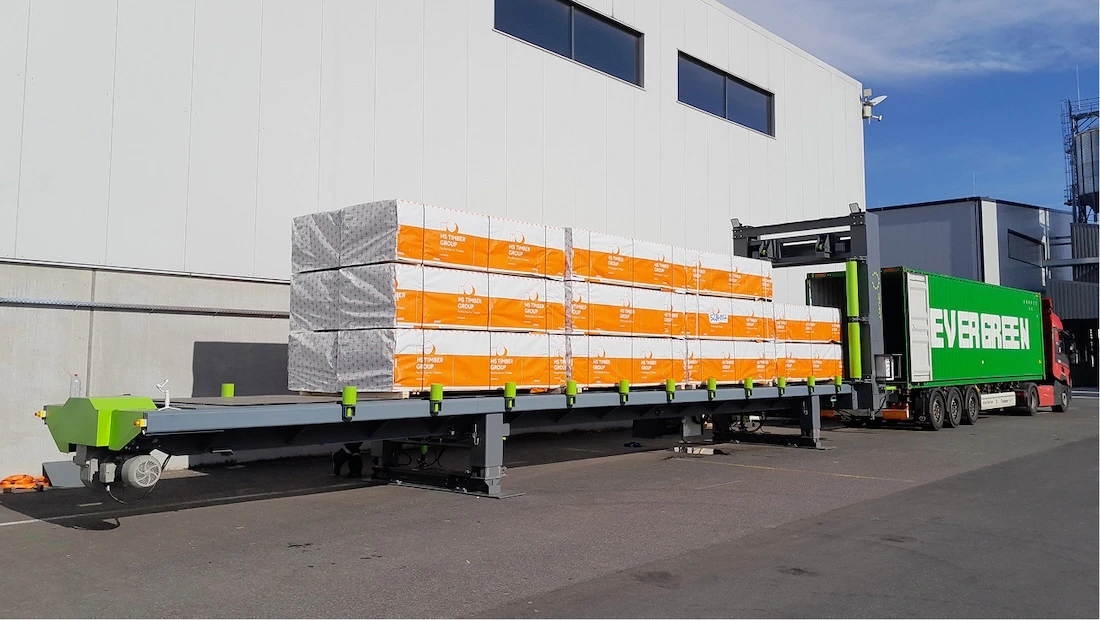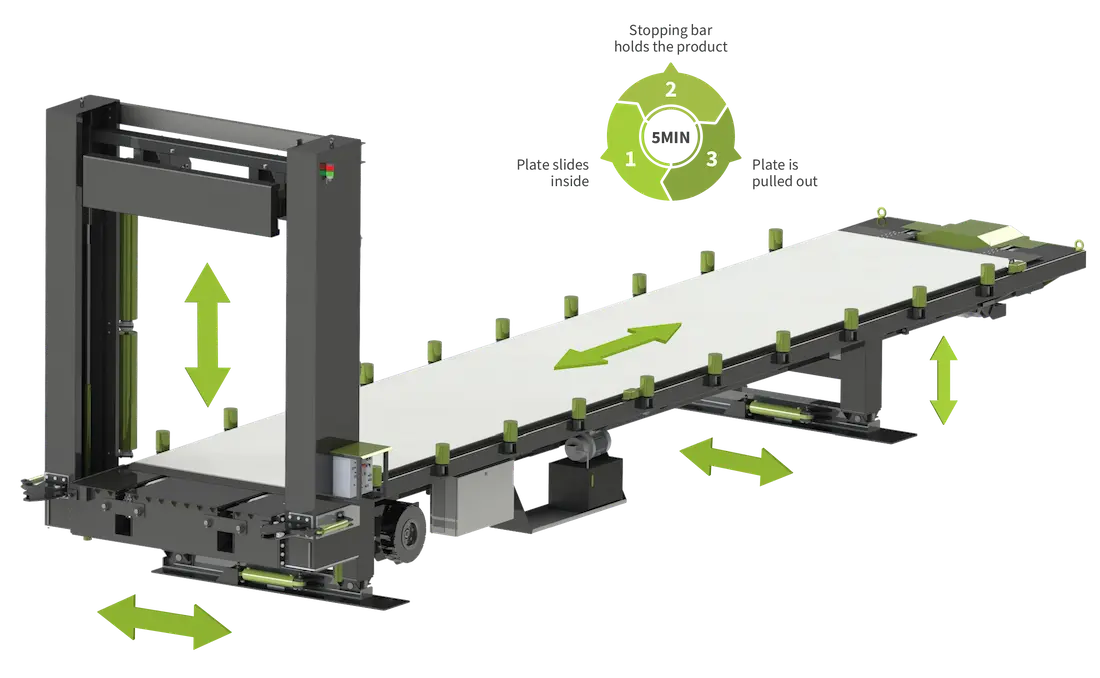20 Benefits of automated container loading

Traditional loading and unloading processes are often slow, labor-intensive, and prone to errors. Missed deadlines, damaged goods, and rising labor costs all add up – and in today’s competitive logistics landscape, that’s a serious disadvantage.
Automated container loading systems solve these challenges by accelerating operations, improving safety, and slashing costs across the supply chain.
Continue reading to learn why integrating a container loading machine into your workflow can be a game-changer for your business.
- Load up to 70% faster: Automate container loading to cut loading times from hours to minutes.
- Reduce labor and equipment costs: Replace multiple workers and forklifts with a single-operator system.
- Minimize damage and accidents: Precision loading protect cargo and reduces on-site injuries.
- Maximize container space: Fit more goods per shipment and reduce the number of trips.
- Scale operations effortlessly: Handle peak demand and growing shipment volumes without increasing headcount.
What is an automated container loading system?
Speed, safety, and efficiency are everything in modern logistics, and that’s where automation comes in. A container loading system is a specialized machine that automatically loads goods into shipping containers and truck trailers.
It replaces most manual labor with a moving loading plate that ensures automatic one-shot loading, saving time and reducing operational risks.
How does the container loading system work?
The loading process is simple and can be completed in as little as five minutes.
After you've placed your cargo on the system’s loading plate, it is automatically pushed into the container or truck trailer in a single, controlled movement. With the cargo inside, the stopping bar holds it in place, and the loading plate retracts.
The machine’s legs, clamps, and gate ensure perfect alignment, preventing damage and optimizing every inch of space.
Key components of a container loading machine
- Loading plate. The plate slides products into containers and truck trailers in one shot, then retracts smoothly from beneath the load.
- Legs. Two sets of legs stabilize the system. Both sets adjust vertically to match container and truck height, while the rear legs also move horizontally for precise alignment.
- Gate. Guides cargo into containers and holds a stopper bar that keeps goods in place as the loading plate retracts.
- Connector clamps. Secure the container or trailer firmly during the loading process, preventing misalignment or movement.
- Gear motor. Powers the loading plate, stopper bar, and other moving components to ensure smooth, controlled operation.
- Control system. Automates the entire container loading process, enabling a single operator to manage the machine efficiently and safely.
Now that you understand how the system works, let’s explore the real value that automation delivers.
20 Benefits of using automated loading
Automated container loading offers much more than just faster operations. From cutting labor expenses and operational costs to improving cargo safety and efficiency, the benefits extend across your entire supply chain.
Efficiency and speed
In logistics, time is money. Automated container loading streamlines operations and reduces loading times by up to 70%. With optimized loading, your business can transport more cargo in less time and maintain a smooth supply chain.
- Ensure consistent loading times. Fewer manual steps mean less human error, quicker container turnover, and shorter delivery lead times.
- Increase daily container throughput. Load more trailers and containers without hiring extra staff or adding shifts.
- Shorten loading and unloading cycles. Reduce downtime at loading docks by preloading your cargo on the container loader before the truck or shipping container arrives.
Cost savings
Labor shortages, rising wages, and inefficient workflows can quickly eat into profits. Automated loading operations deliver long-term savings by ensuring cost efficiency at every level.
- Cut labor costs. Automation minimizes repetitive manual work and reduces the loading crew from multiple workers to just a single operator.
- Lower your maintenance and equipment costs. Less reliance on forklifts and other equipment means fewer repairs and lower maintenance costs.
- Reduce insurance premiums. Fewer accidents and injuries often translate into lower liability and insurance costs.
Safety and risk reduction
Protecting both employees and products is critical in logistics. Automated systems reduce human intervention and create a safer, more controlled working environment.
- Minimize product damage. Precision loading prevents goods from shifting, crushing, or breaking during handling and transit.
- Increase staff safety. Decrease manual labor and risky, improvised loading methods, reducing the likelihood of on-site accidents and safety issues.
- Improve ergonomic conditions. Less heavy lifting and fewer repetitive movements improve ergonomics and staff well-being.
Sustainability and environmental impact
Automation supports leaner, greener logistics by reducing waste and optimizing energy use.
- Decrease energy consumption. Shorter truck idle times and less unnecessary equipment usage lead to lower overall energy consumption.
- Lower harmful emissions. Efficient loading means fewer trips, less fuel consumption, and a smaller carbon footprint.
- Reduce packaging waste. Accurate product stacking and placement minimize the need for excess protective materials.
Space optimization
Every square meter matters in modern logistics. Container loading systems help make the most of your container space, and keep warehouses and loading docks organized and efficient.
- Maximize cargo space. Fill shipping containers to their full capacity, eliminating wasted space and improving shipment efficiency.
- Free up warehouse space. Automation keeps goods consolidated in one area, reducing clutter and making room for other operations.
Operational efficiency and scalability
Automation delivers predictable, high-quality performance and makes it easy to scale operations as demand grows.
- Extend operating hours. Enable longer, more consistent loading cycles with minimal interruptions.
- Ensure weight compliance. Integrated weight monitoring guarantees accurate loads and prevents costly penalties or shipment delays.
- Scale with ease. Container loading systems offer a seamless integration into existing logistics operations and adapt to your business growth.
- Adapt quickly to peak demand. Handle sudden shipment surges without compromising performance or requiring extra labor.
Quality and process consistency
Automatic loading ensures consistent, standardized logistics operations. By following the same optimized procedure every time, the container loading systems ensure predictable, repeatable results.
- Standardize your loading process. Load containers and truck trailers using the same proven method, ensuring uniform stacking, placement, and space utilization.
- Reduce rework and delays. Automation eliminates variability across shipments, allowing operations to run smoothly and reliably every time.

Industries that benefit from automated loading
The advantages of automated loading systems aren’t limited to a single type of operation. Nearly any business that ships or receives goods can benefit from these innovative solutions.
Whether you handle palletized goods, bulk materials, or complex cargo, automation optimizes your loading process, integrates smoothly with other systems, and maximizes ROI.
Here are some of the industries where loading automation has the greatest impact:
Ensure faster container turnover at warehouses and distribution centers to meet tight delivery schedules. Automate loading processes at your existing loading docks to reduce reliance on manual work and cut operational costs.
Load containers with wood and timber products, including sawn timber, wooden boards, and laminated timber. Stack timber precisely to fit more per container and minimize costly breakage.
Handle metal and steel products without hassle. The container loading system helps load metal pipes and tubes, sheet metal, structural steel, and other irregularly shaped or bulky items.
Load construction materials and components like concrete, prefab buildings, sandwich panels, furniture, various fragile items, and more. Handle heavy loads without worrying about potential damage, or safety issues.
Enable higher manufacturing output by ensuring fast and safe loading operations after your products leave the production line. Load palletized goods, bulk cargo, and other products into containers and trucks.

How to get started with automated loading
Consider these key steps to make sure your business transitions smoothly to automated loading and you get the most out of your upgrade.
1. Assess your current workflow
Before investing in a container loading system, take a closer look at your existing logistics processes. Ask yourself these questions:
- Are certain loading tasks repetitive or physically demanding for your team?
- Do you experience frequent delays or bottlenecks at your loading docks?
- Does cargo damage occur frequently during handling or transit?
- Is container or truck space being underutilized?
- Do equipment breakdowns or maintenance issues slow your workflow?
- Do peak periods or sudden shipment surges overwhelm your team?
- Are operational costs steadily increasing due to labor, equipment, or energy use?
If at least a couple of these scenarios sound familiar to you, your business will benefit from loading automation.
The next step is figuring out what type of system you need.
2. Choose the right container loader
Container loading systems come in different shapes and sizes, and are suited for various purposes.
SmartTEH’s container loader is available with three different loading plates:
- Standard plate. Made of high-density polyethylene and suited for loading 40-foot containers.
- Sandwich plate. Made from HDPE and steel, the best option for 20-foot containers.
- Alloy steel plate. The most durable loading plate, enabling container unloading.
All three systems can be extended to handle 45-foot containers and trailers.
3. Start your project
Once you’ve analyzed your current loading workflows and automation needs, it’s time to start planning and building.
Send us a message explaining your requirements and expectations, so we can come up with the best possible solution for your business.
With satisfied clients in over 30 countries, SmartTEH is one of the world’s leading manufacturers of container loading systems. We've developed numerous tailored solutions for various industries, helping businesses save time and money on cargo loading.

Stay competitive with automation
Global logistics is evolving fast – and businesses that adapt stay ahead. Automated container loading isn’t just about replacing manual work. It’s about transforming the way you move cargo, cut costs, and scale your operations.
The sooner you automate, the sooner you’ll see the benefits: fewer delays, fewer risks, and higher profitability.



